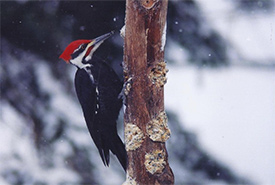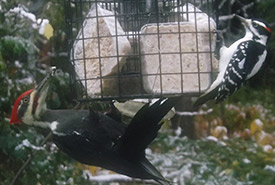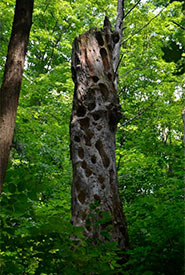Birds of the Happy Valley Forest (Part Three)

Pileated woodpecker, the size of a small crow, is the glamour boy of the Happy Valley Forest. His shouting call is heard throughout the year. (Photo by Dr. Henry Barnett)
Without a doubt the pileated woodpecker is close to the top of dramatic inhabitants of the Happy Valley Forest. Its demanding call is befitting of the crow-like size and overall rugged appearance — wild! One cannot walk in the forest in the spring of the year for more than a few minutes without hearing their demanding notes.

A pileated and hairy woodpecker sharing suet. (Photo by Paul and Vicki Hotte)
Close to the house but at a distance, they only watched our suet logs over the early years. In the past few years they have decided it was safe to feed in the logs or on the feeding platforms. We have had two at a time, and occasionally of late a third will cautiously approach to a non-welcoming reception as a rule. Three pileated woodpeckers on a small feeder platform is quite a sight.
One can find their heads protruding from their characteristically rectangular holes, where they nest annually. A single stump from an unidentified tree (possibly the remains of a pine, or more likely an elm) fairly caught my breath. It is dead and has been literally riddled by the workings of pileated woodpeckers. I would like to think that they were seeking the beetle that killed the tree. The remainder of this hardwood and pine forest is healthy and is as described by Simcoe in his notes, made when he was among the first Europeans who explored the area. Brulé and LaSalle preceded him.

The stump of either an American elm or sugar maple riddled with the characteristic workings of a pileated woodpecker searching for the beetles that killed the tree. (Photo by Dr. Henry Barnett)
Once, still within the Happy Valley Forest, another dead but very tall stump was encircled at daughter Ann’s driveway entrance. Again it was riddled by a pileated woodpecker. At four feet above the ground, it was ringed totally in its circumference. In view of the danger posed by these workings, the stump was removed by the phone company because the next big windstorm might have blown it over the lines. A unique way of getting rid of dead trees — get a friendly pileated woodpecker.
Other woodpeckers, including the abundant hairy and downy woodpeckers with their smaller beaks, never make anything but round holes. Of late, regular visits from a red-bellied woodpecker or even a red-headed and a sapsucker have occurred. The red-headed woodpecker has become very scarce on the Oak Ridges Moraine. They are often killed in migration by passing vehicles as they cross highways with their undulating flight pattern. They appear not to be able to change direction quickly enough, once in swooping flight.
This is the sixth in a series of blog posts Dr. Barnett will be contributing to Land Lines in the next few months.


